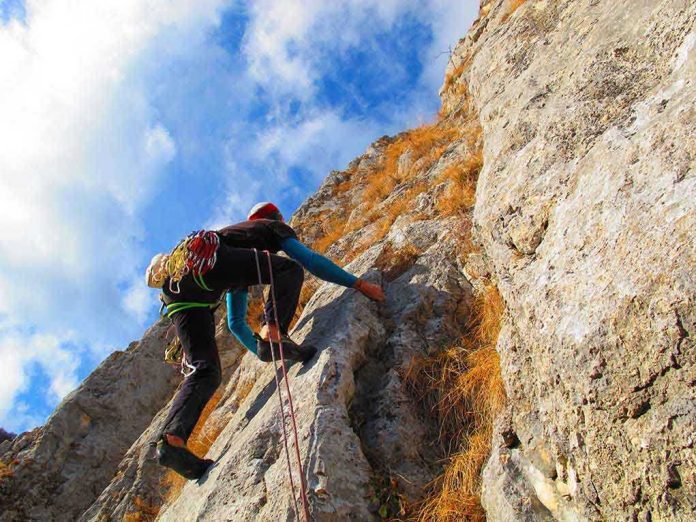
One climber’s brush with death on a Montana cliffside proved a $70 helmet can be all that stands between adventure and catastrophe—a lesson that’s now echoing far beyond the wild crags of the Rockies.
Story Snapshot
- A falling boulder struck climber Cody Boehm, sending him tumbling off a remote Montana cliffside
- Boehm suffered multiple traumatic injuries but survived, crediting his helmet and rescue teams for saving his life
- The incident has reignited debate over helmet use and risk management in climbing communities
- Medical professionals and outdoor experts highlight the helmet as the decisive factor in Boehm’s survival
When a Boulder Falls and Everything Changes
Cody Boehm’s climbing day at Confluence Crag near Red Lodge, Montana, turned into a survival story the moment a microwave-sized boulder broke loose above him. The rock, dislodged by a friend’s footstep, struck Boehm’s helmet squarely, then his body, before hurling him off the cliffside. The force shattered his collarbone, broke seven ribs, collapsed a lung, and left a gash in his back. Yet, amid the chaos, Boehm’s helmet absorbed the fatal blow—transforming a certain tragedy into a fight for life.
Friends scrambled to his aid, performing first aid on the precarious ledge and placing a desperate call for help. The wilderness, dense and unforgiving, complicated everything. But rescue teams—Red Lodge Fire Rescue, local search and rescue, and Custer Gallatin National Forest rangers—mobilized with speed and precision. They cleared trails, coordinated the extraction, and transported Boehm over rough terrain to a waiting ambulance. Every step, from trail clearing to medical evacuation, played out like a high-stakes relay—one misstep and the outcome could have changed.
The Hidden Dangers Behind Every Ascent
Montana’s Beartooth Mountains, beloved by climbers for their wild beauty, have always harbored hazards beneath the surface. Rockfall is a known peril, worsened by loose geology and the growing popularity of outdoor climbing. With each climber ascending, the odds shift—one misplaced foot, one unstable ledge, and the mountain reminds even the most skilled that control is sometimes an illusion. Boehm’s accident, though dramatic, is part of a larger pattern: as more people seek adventure, the risks multiply, and the margin for error shrinks.
The rescue was not just a triumph of logistics, but of community. Boehm’s friends made quick decisions under pressure, local teams executed a complex extraction, and doctors at Billings Clinic delivered trauma care that ensured Boehm would live to tell the tale. The interdependence among climbers, rescuers, and medical professionals forms a chain that, when tested, must hold strong. This incident reaffirmed the importance of training—not just for the climb, but for the unpredictable moments that follow disaster.
One Helmet, Countless Debates: The Culture of Safety in Climbing
Boehm’s story has rekindled an old debate in climbing circles: Is that extra weight on your head worth the inconvenience? For Boehm, the answer is unequivocal. He credits his survival to the helmet, echoing the assessment of Dr. Gordon Riha, the trauma surgeon who treated him. “If he wasn’t wearing a helmet, he would have had significant and severe intracranial injury, which likely would have been life-threatening,” Dr. Riha affirmed. Despite hard evidence and expert testimony, discussions about helmet use remain surprisingly fraught, with some climbers dismissing helmets as unnecessary or uncomfortable for certain routes.
Medical studies and accident reports consistently show that helmets reduce the severity of head injuries in climbing accidents. The parallels to seat belts in cars or helmets in cycling are unavoidable: most people only reconsider their choices after seeing the consequences up close. Boehm, now a vocal advocate, hopes his ordeal shifts that calculus for others. His message is simple, direct, and urgent: “Your helmet will save your life no matter what. If I didn’t have my helmet on, I wouldn’t be here today.”
Rescue, Recovery, and the Ripple Effects in Outdoor Culture
Boehm’s survival is not just a personal victory but a teachable moment for the entire outdoor recreation community. In the aftermath, local outfitters and climbing organizations have renewed their calls for helmet adoption and wilderness preparedness. The story has also prompted gear manufacturers to intensify safety messaging, and some land managers are reviewing signage and protocols at popular climbing sites. The economic toll of rescue operations and medical care is real, but the social impact—heightened awareness, changed habits, and perhaps a few lives saved down the line—may prove far more significant.
Boehm’s recovery continues, and he intends to return to climbing. The story’s lessons will persist long after his scars heal: risk is inherent, but preparedness—especially when it’s as simple as buckling a helmet—can mean the difference between a news headline and a eulogy. As the mountains call to a new generation of adventurers, his story remains a stark reminder: some miracles are engineered, not wished for.










